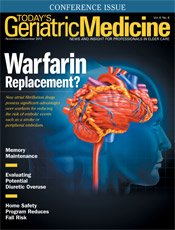
November/December 2013
Preventing Falls: Time for ActionBy Diane L. Schneider, MD, MSc Falls are one of the greatest threats to health and independence among older adults. Falls rise exponentially with age after the sixth decade. At every age, those with frailty syndrome or multiple comorbidities have a greater vulnerability to falls than those without. The GLOW study, a multinational longitudinal study of more than 600,000 women aged 55 and older, showed that frail and prefrail status is associated with a substantially higher risk of recurrent falls and fractures. The risk did not vary substantially over different age ranges from the fifth through the ninth decades of life. Results from the same cohort demonstrated that chronic medical conditions such as Parkinson’s disease, COPD, diabetes, osteoarthritis, and heart disease increase the risk of falls and fractures. Fall statistics gathered by the Centers for Disease Control and Prevention (CDC) include the following: • Each year, one-third of people aged 65 and older experience a fall. • Fewer than one-half of the Medicare beneficiaries who fell in the previous year talked to their health care providers about it. • Every 29 minutes an older adult dies from a fall. • One in five falls causes a serious injury such as head trauma or fracture. • Each year, more than 2 million older adults are treated in emergency departments for nonfatal fall injuries. • Direct medical costs for fall injuries total more than $28 billion annually. We are doing a poor job of assessing fall risk and providing strategies to prevent falls in our older adult population. Are we overlooking fall risk because there is no magic pill, too many other issues, or no simple measurement to take? Fall risk assessment requires attention to detail and additional time. In each patient encounter, we need to inquire about falls. Ask all your patients aged 65 and older about falls and injuries from falls. Take a systematic approach by including falls in your history template or adding a fall question as part of the vital sign assessment. Instruct your patients to contact you if a fall occurs, so you can work together to try to prevent the next one. A history of falls predicts future falls. Fall history is the single strongest risk factor associated with subsequent falls. The 2012 US Preventive Services Task Force (USPSTF) guideline for fall prevention in community-dwelling older adults recommended that for risk assessment, primary care clinicians should identify older adults at increased risk of falls by a history of falls, a history of mobility problems, and poor performance on the Timed Up and Go test. For this test, a person is asked to rise from an armchair, walk 10 feet, turn, walk back, and sit while he or she is observed and timed. A cutoff point of 12 seconds or longer has been used to predict community-dwelling individuals who are more likely to fall. The CDC’s Injury Center created the STEADI (Stopping Elderly Accidents, Deaths & Injuries) Tool Kit for health care providers. The CDC recommends evaluating gait, strength, and balance with three tests: Timed Up and Go, 30-Sec Chair Stand, and 4-Stage Balance Test. If problems are identified, then additional multifactorial risk evaluation and fall interventions are recommended. A 2012 Cochrane Review of interventions to reduce the risk of falls in community-dwelling older adults included studies of several different types of exercise programs. Multicomponent group exercise, multicomponent home-based exercise, and tai chi significantly reduced the risk of falls. The USPSTF guideline recommended intervention consisting of exercise or physical therapy and vitamin D supplementation. Exercise training that improves balance, core, and quadriceps strength can reduce recurrent falls. The simple measure of supplementing vitamin D (700 to 1,000 IU/day) reduced fall risk and achieving serum 25(OH)D concentrations of 24 ng/mL or higher reduced fall risk in high-risk individuals. Other interventions differed in effectiveness by functional status and living situation. Modifiable risk factors should be tailored to the individual. Many elders are admitted to rehabilitation and long term care facilities as a result of fractures resulting from a fall. However, a patient’s fall history commonly is overlooked, as is a patient’s underlying osteoporosis. Both falls and osteoporosis need to be addressed in planning treatment. Don’t overlook the opportunity to lower the risk of falls in both frail and active patients. — Diane L. Schneider, MD, MSc, is retired from the University of California, San Diego; cofounder and medical editor of 4BoneHealth.org, and author of the consumer book The Complete Book of Bone Health. |
